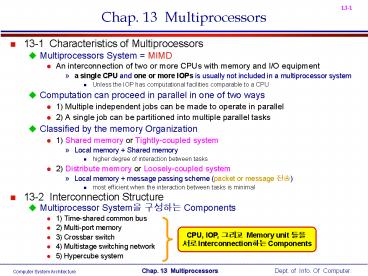Chap' 13 Multiprocessors - PowerPoint PPT Presentation
1 / 10
Title:
Chap' 13 Multiprocessors
Description:
An interconnection of two or more CPUs with memory and I/O equipment ... Rotating daisy-chain * Bus Busy Line ??. If this line is inactive, ... – PowerPoint PPT presentation
Number of Views:392
Avg rating:3.0/5.0
Title: Chap' 13 Multiprocessors
1
Chap. 13 Multiprocessors
- 13-1 Characteristics of Multiprocessors
- Multiprocessors System MIMD
- An interconnection of two or more CPUs with
memory and I/O equipment - a single CPU and one or more IOPs is usually not
included in a multiprocessor system - Unless the IOP has computational facilities
comparable to a CPU - Computation can proceed in parallel in one of two
ways - 1) Multiple independent jobs can be made to
operate in parallel - 2) A single job can be partitioned into multiple
parallel tasks - Classified by the memory Organization
- 1) Shared memory or Tightly-coupled system
- Local memory Shared memory
- higher degree of interaction between tasks
- 2) Distribute memory or Loosely-coupled system
- Local memory message passing scheme (packet or
message ??) - most efficient when the interaction between tasks
is minimal - 13-2 Interconnection Structure
- Multiprocessor System? ???? Components
- 1) Time-shared common bus
- 2) Multi-port memory
CPU, IOP, ??? Memory unit ?? ??
Interconnection?? Components
2
- Time-shared Common Bus
- Time-shared single common bus system Fig. 13-1
- Only one processor can communicate with the
memory or another processor at any given time - when one processor is communicating with the
memory, all other processors are either busy with
internal operations or must be idle waiting for
the bus - Dual common bus system Fig. 13-2
- System bus Local bus
- Shared memory
- the memory connected to the common system bus is
shared by all processors - System bus controller
- Link each local but to a common system bus
Tightly coupled system
3
- Multi-port memory Fig. 13-3
- multiple paths between processors and memory
- Advantage high transfer rate can be achieved
- Disadvantage expensive memory control logic /
large number of cables connectors - Crossbar Switch Fig. 13-4
- Memory Module? I/O Port? ??? ??? Crossbar
Switch? ???? ? - Block diagram of crossbar switch Fig. 13-5
CPUs
MM
4
Crossbar Switch ?? ??
5
- Multistage Switching Network
- Control the communication between a number of
sources and destinations - Tightly coupled system PU MM
- Loosely coupled system PU PU
- Basic components of a multistage switching
network - two-input, two-output interchange switch
Fig. 13-6 - ?? ) 2 Processor (P1 and P2) are connected
through switches to 8 memory modules (000 - 111)
Fig. 13-7 - Omega Network Fig. 13-8
- 2 x 2 Interchange switch? ???? N input x N
output network topology ??
6
- Hypercube Interconnection Fig. 13-9
- Loosely coupled system?? ??
- Hypercube Architecture ?? Intel iPSC ( n 7,
128 node ) - 13-3 Interprocessor Arbitration Bus Control
- Single Bus System Address bus, Data bus,
Control bus - Multiple Bus System Memory bus, I/O bus, System
bus - System bus Bus that connects CPUs, IOPs, and
Memory in multiprocessor system - Data transfer method over the system bus
- Synchronous bus achieved by driving both units
from a common clock source - Asynchronous bus accompanied by handshaking
control signals
7
- System Bus ?? IEEE Standard 796 MultiBus
- 86 signal lines Tab. 13-1
- Bus Arbitration ??? BREQ, BUSY,
- Bus Arbitration Algorithm Static / Dynamic
- Static priority fixed
- Serial arbitration Fig. 13-10
- Parallel arbitration Fig. 13-11
- Dynamic priority flexible
- Time slice (fixed length time)
- Polling
- LRU
- FIFO
Bus Busy Line ?? If this line is inactive,
no other processor is using the bus
8
- 13-4 Interprocessor Communication
Synchronization - Interprocessor Communication
- shared memory tightly coupled system
- Accessible to all processors common memory
- Act as a message center similar to a mailbox
- no shared memory loosely coupled system
- message passing through I/O channel communication
- Interprocessor Synchronization
- Enforce the correct sequence of processes and
ensure mutually exclusive access to shared
writable data - Mutual Exclusion
- Protect data from being changed simultaneous by
two or more processor - Mutual Exclusion with Semaphore
- Critical Session
- Once begun, must complete execution before
another processor accesses - Semaphore
- Indicate whether or not a processor is executing
a critical section - Hardware Lock
- Processor generated signal to prevent other
processors from using system bus
9
- Semaphore? ??? shared memory ?? ??
- 1) TSL SEM ?? ?? (Test and Set while Locked)
- Hardware Lock ??? ?????? SEM ??? ??
- 2 memory cycle ??
- Test semaphore
(semaphore? ???? R? ?? ???) - Set semaphore (??
processor? shared memory ??? ??) - 2) R 0 ? ?? shared memory is available
- R 1 ? ?? processor can not access
shared memory (semaphore - originally set)
- 13-5 Cache Coherence
- Conditions for Incoherence Fig. 13-12, 13
- Multiprocessor system with private caches
- Write through P2, P3 Incoherence
- Write back P2, P3, Main memory Incoherence
P1 ? X ? 120 ? Write ?? ??
10
- Solution to the Cache Coherence Problem
- Software ?? ??
- 1) Shared writable data are non-cacheable
- 2) Writable data exists in one cache
Centralized global table - Hardware ?? ??
- 1) Monitor possible write operation Snoopy
cache controller - ?? ??
- IEEE Computer, 1988, Feb.
- Synchronization, coherence, and event
ordering in multiprocessors - IEEE Computer, 1990, June.
- A survey of cache coherence schemes for
multiprocessors

